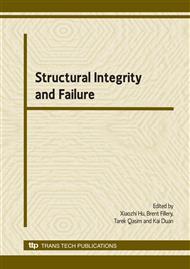p.317
p.323
p.329
p.335
p.341
p.349
p.357
p.363
p.369
Study on Interlaminar Shear and Damage Behavior of Carbon Fiber Composites with Short Fiber Interleaves: 2. Micro-Mechanical Simulation
Abstract:
A micro-mechanical model and simulation for the damage behavior of short fiber interleaves (SFIs) were developed based on Mori-Tanaka method and an equivalent approach to interface debonding (Fitoussi etc 1990). The damage evolution and the stress-strain relation of SFIs have been predicted in the cases of interlaminar shear, out-of and in-plane tension, respectively. The simulation indicates that the damage always starts from the interface debonding of fibers perpendicular to load and the matrix cracking in the direction parallel to fibers, and then rapidly spreads to more fibers during loading. The strength and the ultimate strain in out-of-plane tension are much lower than that in interlaminar shear and in-pane tension. The strength and failure probability of interface bonding are the most considerable factors to affect the damage and failure of SFIs. The comparison of the simulation with the interlaminar shear test shows a good agreement.
Info:
Periodical:
Pages:
341-347
Citation:
Online since:
April 2008
Authors:
Price:
Сopyright:
© 2008 Trans Tech Publications Ltd. All Rights Reserved
Share:
Citation:


